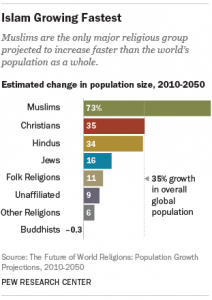The inquiry into the world’s largest religion is a profound one, sparking debates that delve into doctrinal, sociological, and historical dimensions. Presently, Christianity and Islam are often cited as the two largest faiths globally, each with its own extensive following and complex theological frameworks. This discourse seeks to illuminate the attributes of both religions, alongside others, and offer a Christian perspective on their standings within the contemporary religious landscape.
Demographic Overview
As of recent estimations, Christianity boasts approximately 2.3 billion adherents, constituting nearly one-third of the global population. Conversely, Islam, with around 1.9 billion followers, is rapidly growing, projected to potentially eclipse Christianity in the coming decades. The reasons for this demographic shift are multifaceted, encompassing factors such as higher birth rates among Muslim populations and conversion trends. Furthermore, the rise of secularism and religious pluralism in various regions prompts a re-evaluation of traditional affiliations, yet the tenets of Christianity remain pivotal in many societies.
Understanding Christianity
Christianity, rooted in the life and teachings of Jesus Christ, is marked by its emphasis on the redemptive power of grace, the importance of faith, and the pursuit of a personal relationship with God. Central to Christian belief is the Holy Trinity—Father, Son, and Holy Spirit—which distinguishes it from other religions, facilitating a unique narrative of salvation history. Various denominations, from Catholicism to Orthodoxy and Protestantism, contribute to a rich tapestry of theological interpretations and practices. This diversity underscores the adaptability of Christian doctrine in addressing contemporary moral and ethical dilemmas.
Each denomination articulates distinct views on salvation, scripture, and sacraments, fostering an environment of dialogue and, at times, tension. However, common foundational truths unite these factions. For instance, the celebration of Christ’s resurrection during Easter, and the observance of compassionate acts through charity resonate across denominational lines. These shared beliefs invigorate the Christian mission, emphasizing evangelism and social justice as means to embody faith in action.
The Rapid Growth of Islam
Islam, with its roots in the revelations received by the Prophet Muhammad in the 7th century CE, is characterized by its five pillars: the declaration of faith (Shahada), daily prayers (Salah), almsgiving (Zakat), fasting during Ramadan, and the pilgrimage to Mecca (Hajj). These fundamental practices encapsulate the essence of Islamic devotion and community cohesion. The faith centers around the Quran, believed to be the literal word of God, and the Hadith, which comprises the sayings and actions of the Prophet Muhammad.
Islamic teachings promote a comprehensive way of life, integrating spiritual, ethical, and legal components, culminating in the concept of Ummah, the global community of Muslims. This interconnectedness fosters a profound sense of belonging, further propagated by the emigration of Muslims to Western nations, where the establishment of vibrant Islamic communities has become increasingly visible. Yet, this expansion invites scrutiny and dialogue about the cultural integration of Islamic values within predominantly Christian societies.
Interfaith Dynamics
The interaction between Christianity and Islam is crucial to understanding contemporary religious dynamics. Both faiths claim a significant portion of the prophetic lineage, recognizing figures such as Abraham and Moses. The theological discussions concerning the nature of God, the role of prophets, and the afterlife provoke ongoing dialogue. Challenging to navigate, these conversations often oscillate between mutual respect and fervent disputes over doctrinal differences.
In the face of increasing interfaith tensions, particularly in geopolitical contexts, the pursuit of dialogue becomes imperative. Christian organizations engage in interfaith initiatives aiming to foster understanding and peace. These endeavors reflect a commitment to Christ’s teachings of love and reconciliation, seeking common ground while acknowledging distinct identities. The aim is not only to coexist but also to cultivate a culture rooted in empathy and respect for diverse beliefs.
Emerging Religions and Spiritualities
While Christianity and Islam dominate the religious sphere, other spiritual movements are on the rise. Religions such as Hinduism, Buddhism, and newer ideological frameworks such as agnosticism and atheism create a pluralistic environment that complicates straightforward comparisons among faiths. Each of these belief systems holds unique perspectives on the divine and human existence, thus enriching the tapestry of global spirituality.
The increasing visibility of alternative spiritualities often reflects societal shifts towards individualism, with people seeking personalized beliefs that resonate with their personal experiences. This poses challenges to traditional religious structures, compelling a reevaluation of engagement strategies employed by established faiths such as Christianity. In response, many Christians are exploring innovative ways to articulate their faith in an increasingly skeptical world.
Conclusion
In summation, the dialogue surrounding the largest religion in the world is far from simplistic; it intertwines historical trajectories, cultural evolutions, and the evolving nature of belief systems. Christianity remains a formidable presence, sustained by its rich traditions and commitment to spreading the gospel. Meanwhile, the dynamic growth of Islam and alternative spiritualities necessitates a responsive approach, fostering dialogue rather than division. As adherents of different faiths navigate the complexities of our interconnected world, empathy and understanding stand as fundamental principles guiding the discourse. Ultimately, the landscape of spirituality is ever-evolving, reflecting the myriad ways humans search for meaning, connection, and transcendence in an increasingly pluralistic society.



